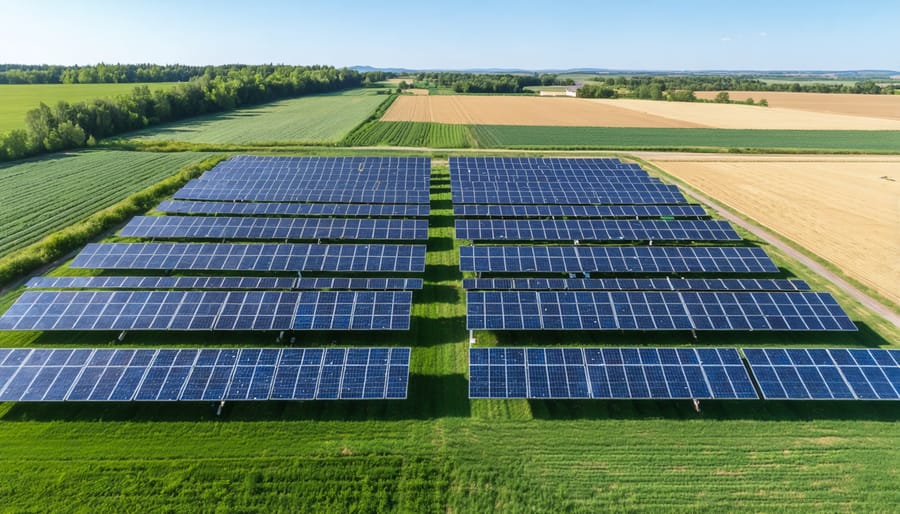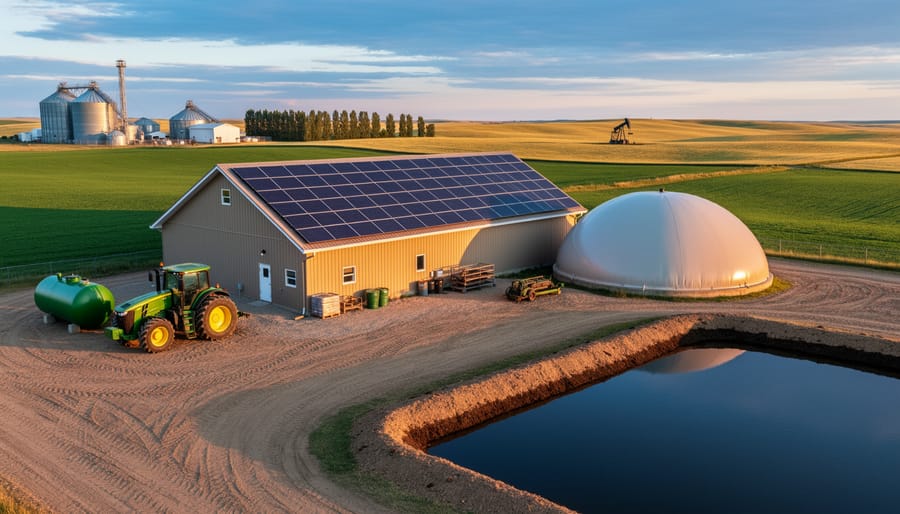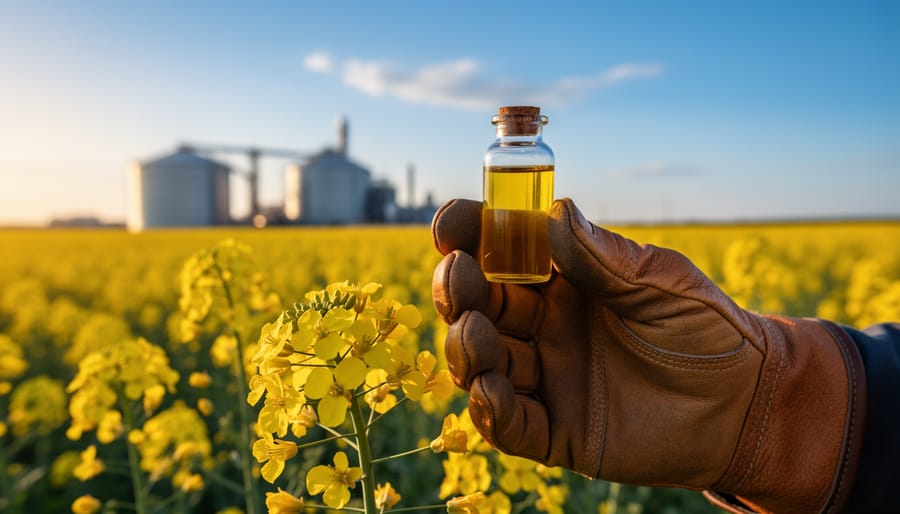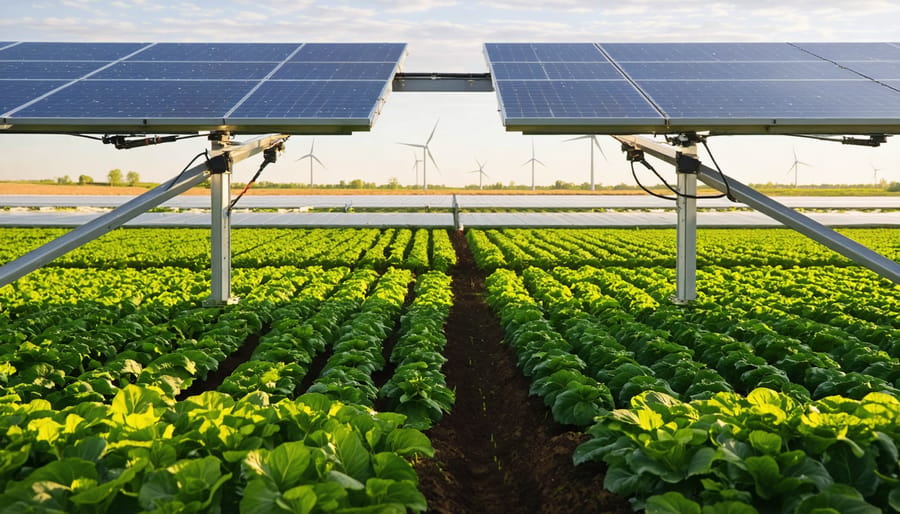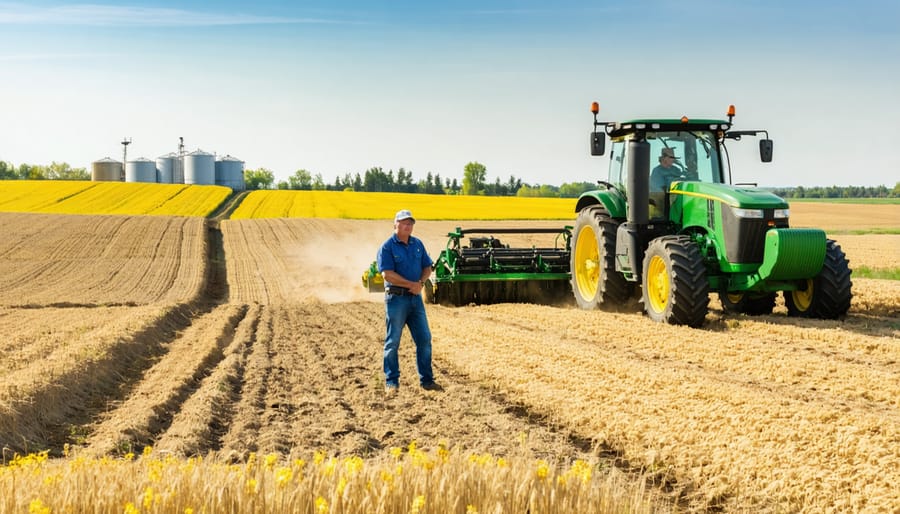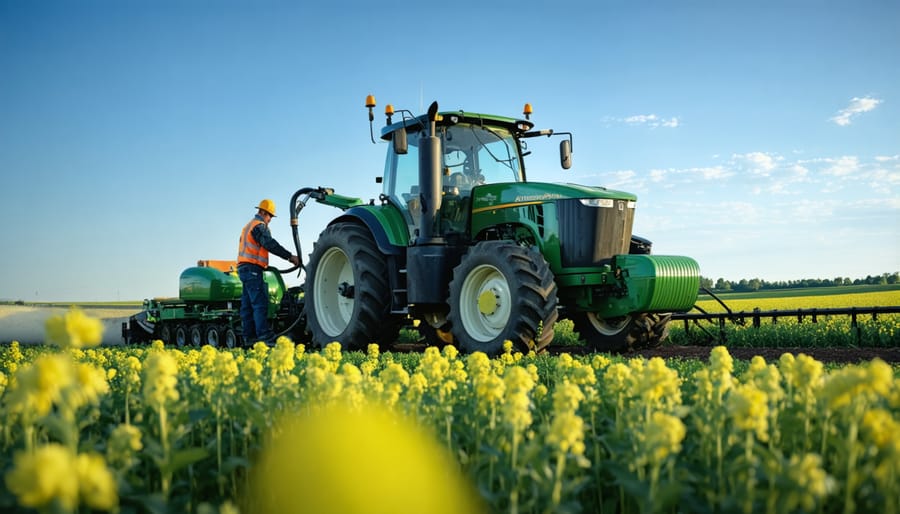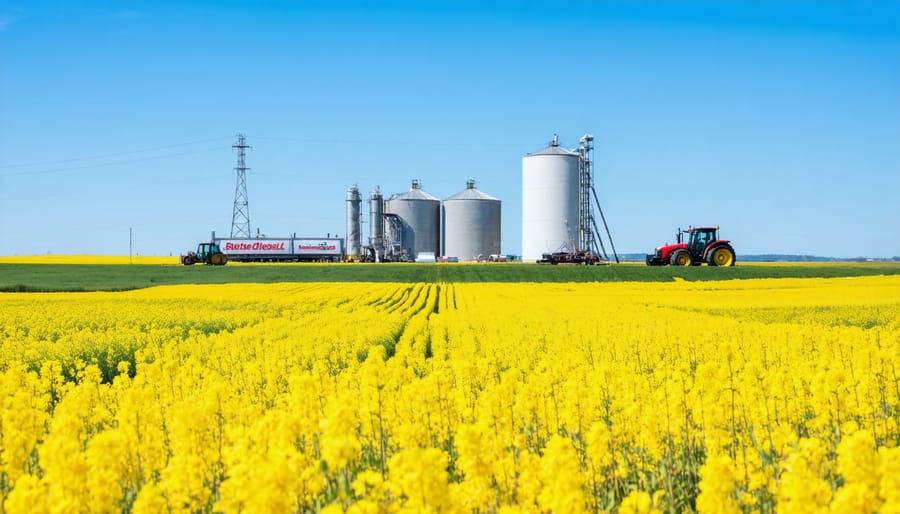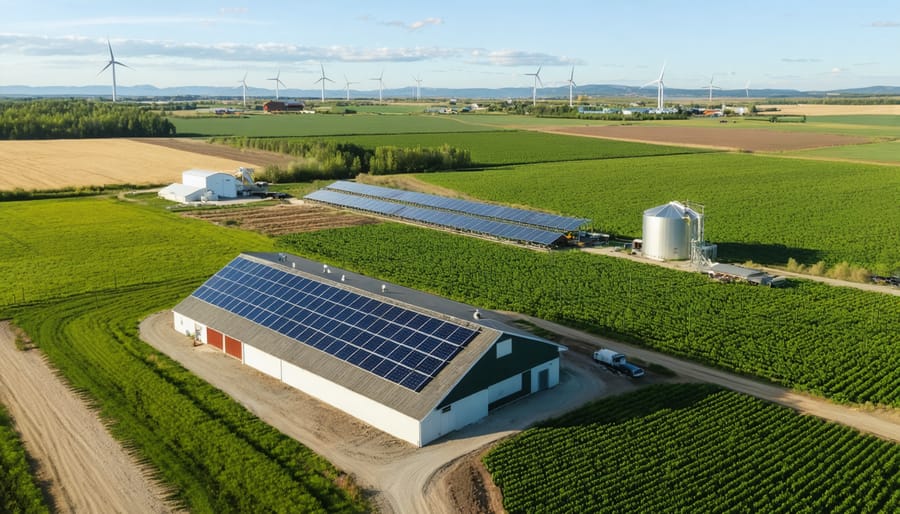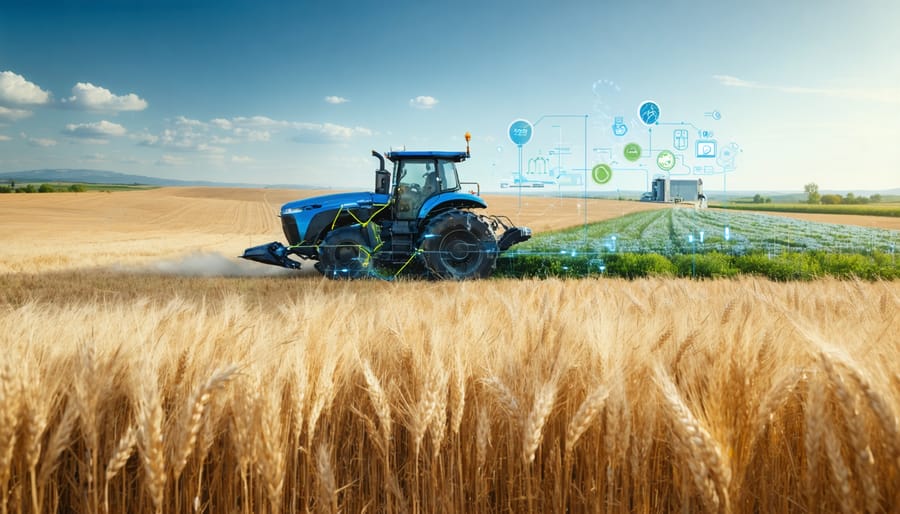Harness the power of IoT sensors to optimize solar panel positioning and maximize energy collection across your agricultural operations. Smart monitoring systems now transform Alberta farms by reducing energy costs up to 40% through automated tracking and real-time adjustment of renewable energy systems. Connect weather prediction algorithms with smart irrigation controls to automatically schedule water pumps during peak solar generation periods, ensuring optimal energy utilization. Integrate IoT-enabled power management systems to distribute renewable energy efficiently between essential farm operations, from greenhouse climate control to grain drying facilities.
Modern farming demands intelligent energy solutions, and IoT technology bridges the gap between traditional agriculture and sustainable power generation. By implementing these smart systems, Canadian farmers are cutting operational costs while contributing to environmental stewardship. Real-time data analytics from IoT devices enable precise matching of energy production with consumption patterns, creating a more resilient and sustainable agricultural operation.
How IoT and AI Are Powering Alberta’s Agricultural Revolution
Smart Solar Tracking Systems
Smart solar tracking systems are revolutionizing how Alberta farms harvest solar energy, with AI-powered panels that automatically adjust their position throughout the day to capture maximum sunlight. These intelligent systems use sensors and machine learning algorithms to track the sun’s movement, resulting in up to 30% more energy production compared to fixed solar installations.
For example, at the Morrison Family Farm near Drumheller, their smart tracking system adjusts panels across two axes, accounting for both daily sun movement and seasonal changes. Weather sensors protect the panels by automatically positioning them flat during high winds or hail, while snow sensors trigger tilting to shed winter accumulation.
The system’s IoT capabilities allow farmers to monitor performance through their smartphones, with real-time data on energy production, panel positioning, and maintenance needs. Local success stories show these systems paying for themselves within 5-7 years through increased energy generation and reduced operational costs.
What’s particularly valuable for Canadian farmers is how these systems adapt to our northern latitude, maximizing the shorter daylight hours during winter months when every bit of solar exposure counts.
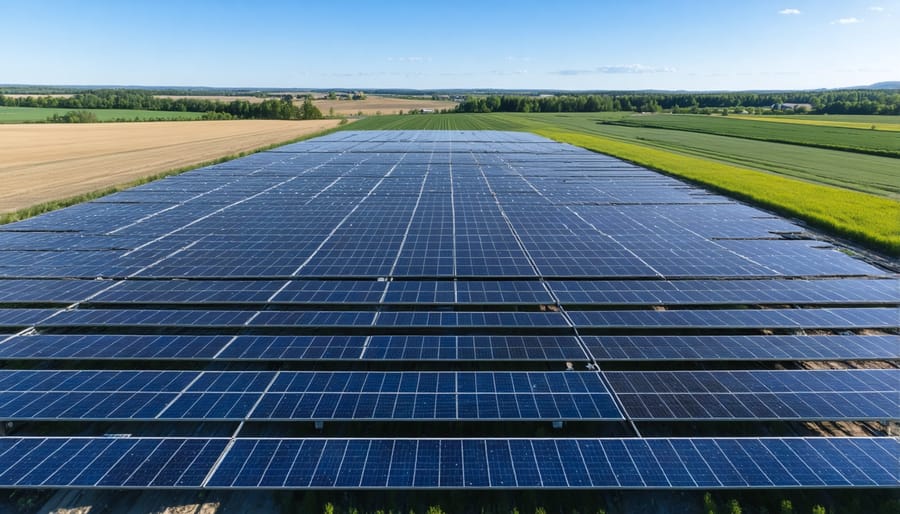
Intelligent Wind Energy Management
Modern wind turbines are becoming increasingly intelligent thanks to IoT integration, helping Alberta farmers maximize their renewable energy production. These smart systems use an array of sensors to monitor wind speed, direction, turbine blade angles, and mechanical stress in real-time, ensuring optimal performance throughout the year.
Local farmer Mike Thompson from Lethbridge County reports a 23% increase in energy output after implementing IoT sensors on his farm’s 60-metre turbine. “The system automatically adjusts blade pitch based on wind conditions, something we previously had to monitor manually,” Thompson explains.
These smart sensors also predict maintenance needs by detecting unusual vibrations or temperature changes, helping farmers prevent costly breakdowns before they occur. Weather pattern analysis through connected devices enables automatic turbine positioning to capture maximum wind energy, particularly useful during Alberta’s characteristically strong chinook winds.
For multi-turbine operations, IoT systems coordinate turbine positioning to minimize wake effect, where upwind turbines reduce efficiency for those downwind. This smart management approach has helped several Peace Region farms achieve up to 15% better overall farm energy efficiency compared to traditional wind setups.
Real-Time Energy Monitoring and Management
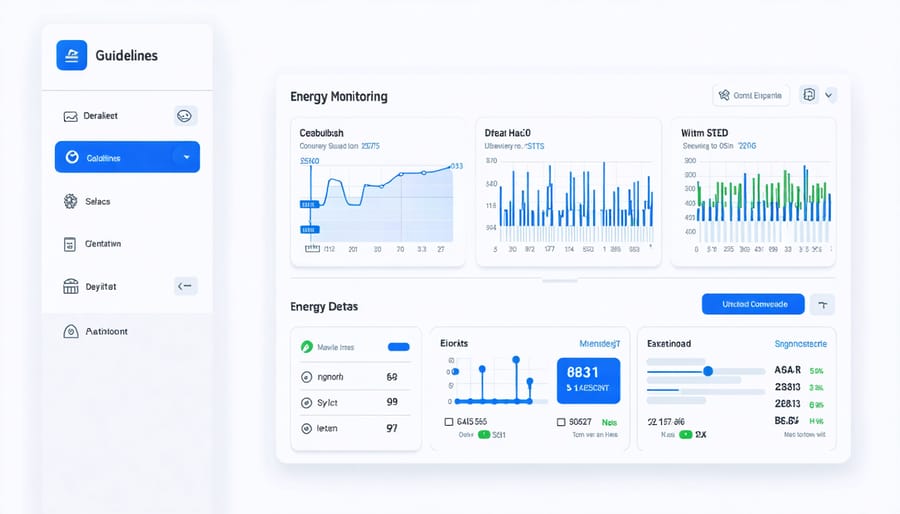
Smart Meters and Energy Distribution
Modern farms are increasingly turning to smart energy monitoring systems to optimize their power distribution and consumption. These intelligent meters work seamlessly with renewable energy sources, providing real-time data on energy usage across different farm operations, from irrigation systems to barn ventilation.
For Alberta farmers, the integration of smart meters has proven particularly valuable during peak growing seasons when energy demands fluctuate significantly. These systems can automatically adjust power allocation based on priority needs, ensuring critical operations receive consistent power while reducing waste in less essential areas.
When combined with energy storage solutions, smart meters create a robust energy management network. For example, the Peterson Family Farm in Southern Alberta reduced their energy costs by 30% after implementing smart meters that direct excess solar power to storage during low-demand periods and redistribute it during peak usage times.
The technology also enables farmers to monitor and control their energy systems remotely through smartphone apps, making it easier to manage power distribution even when working in distant fields. This level of control helps maintain optimal conditions in temperature-sensitive areas like greenhouse operations and livestock buildings while maximizing the efficiency of renewable energy systems.
Predictive Maintenance through AI
In Alberta’s renewable energy landscape, AI-powered predictive maintenance has become a game-changer for farm operations. By analyzing data from IoT sensors across solar panels, wind turbines, and biomass systems, artificial intelligence can spot potential issues before they become costly problems.
Take the Smith family farm near Lethbridge, for example. Their smart monitoring system detected unusual vibrations in their wind turbine’s gearbox last winter, allowing them to schedule maintenance during a planned downtime rather than facing an emergency repair during harvest season. This proactive approach saved them nearly $12,000 in potential repair costs and prevented two weeks of system downtime.
The AI systems work by establishing baseline performance patterns and continuously monitoring for deviations. When your solar panels are collecting data about their energy production, temperature, and environmental conditions, the AI can predict when cleaning or repairs might be needed. For wind turbines, it analyzes everything from blade pitch to bearing temperatures, helping you schedule maintenance during optimal weather windows.
Local agricultural technology provider Prairie Tech Solutions reports that farms using AI-driven maintenance typically see a 30% reduction in unexpected equipment failures and a 25% decrease in maintenance costs. The system can even adjust maintenance schedules based on weather forecasts and peak energy demand periods, ensuring your renewable energy system stays reliable when you need it most.
Case Study: Thompson Family Farm’s IoT Success
Located just outside of Olds, Alberta, the Thompson Family Farm has become a shining example of how IoT and renewable energy can transform traditional farming operations. In 2019, John and Sarah Thompson made the bold decision to modernize their 1,200-hectare grain farm by implementing a comprehensive IoT-enabled renewable energy system.
The Thompsons installed a 75-kilowatt solar array combined with smart monitoring systems to power their grain drying and storage facilities. They integrated IoT sensors throughout their operation, connecting everything from weather stations to soil moisture monitors through a central management platform accessible via their smartphones.
“The system paid for itself faster than we expected,” explains John Thompson. “We’re saving about $18,000 annually on energy costs, and the real-time monitoring helps us make better decisions about when to run our equipment.” The farm’s energy consumption has dropped by 40% since implementation, with peak-hour usage reduced by 60%.
Key to their success was the strategic placement of IoT sensors across their solar installation. These devices continuously monitor panel performance, weather conditions, and energy consumption patterns. When dust accumulation on panels reaches critical levels, the system automatically alerts the Thompsons, ensuring optimal energy generation.
The farm’s smart storage facilities now operate based on real-time data. During harvest, grain dryers automatically adjust their operation to take advantage of peak solar production hours, while battery storage systems ensure consistent power supply during cloudy days.
Perhaps most impressive is how the Thompsons have shared their experience with the local farming community. They regularly host educational tours for neighboring farmers, demonstrating how IoT and renewable energy can work in real-world agricultural settings. “It’s about showing others that this technology isn’t just for big corporations,” Sarah Thompson notes. “It’s practical, profitable, and perfectly suited for Canadian family farms.”

Practical Implementation Steps for Your Farm
Initial Assessment and Planning
Before implementing IoT solutions for renewable energy on your farm, start with a thorough assessment of your current energy consumption patterns. Track your monthly power usage across different operations, from irrigation systems to equipment charging stations. Consider seasonal variations – Alberta farms typically see higher energy demands during seeding and harvest seasons.
Create a detailed energy audit by measuring peak usage times and identifying areas where renewable solutions could have the most impact. Many Alberta farmers find that combining smart meters with weather monitoring systems helps optimize energy planning. For example, the Thompson family farm in Red Deer reduced their energy costs by 30% after mapping their usage patterns and strategically placing solar panels.
Work with local agricultural extension services to evaluate your farm’s renewable energy potential. Consider factors like available roof space for solar panels, wind patterns, and proximity to power lines. Remember to account for future expansion plans and seasonal equipment needs when sizing your system.
System Selection and Installation
When selecting an IoT renewable energy system for your farm, start by conducting a thorough energy audit to determine your specific needs. Consider factors like seasonal power consumption patterns, available space, and local climate conditions. Many Alberta farmers have found success with hybrid systems that combine solar integration strategies with wind power, particularly in areas experiencing both sunny days and consistent wind patterns.
Installation should be handled by certified professionals familiar with agricultural applications. Ensure your chosen system includes smart monitoring capabilities, weather-resistant sensors, and robust data collection tools. Position solar panels where they won’t interfere with farming operations, typically on barn roofs or unused field corners. Install wind turbines at optimal heights, considering surrounding structures and vegetation.
Connect with local agricultural extension offices for guidance on permits and regulations. Many regions offer incentives for renewable energy installations, making the initial investment more manageable. Remember to factor in maintenance requirements and ensure your system can be easily upgraded as technology advances.
The integration of IoT and renewable energy systems represents a transformative opportunity for Canadian farms to enhance their sustainability and operational efficiency. Through smart monitoring, automated controls, and data-driven decision-making, farmers can optimize their energy usage while contributing to environmental conservation.
As we’ve seen from successful implementations across Alberta, the benefits extend far beyond energy savings. From reduced operational costs to improved crop yields and enhanced farm resilience, IoT-enabled renewable energy systems are proving their worth in real-world agricultural settings.
For farmers considering this transition, numerous resources and support networks are available. The Canadian Agricultural Partnership offers funding programs specifically designed to help farms adopt clean technology solutions. Local agricultural extension offices provide technical guidance and connection to experienced professionals who can assist with system design and implementation.
Additionally, farmer-led organizations across Alberta host regular workshops and knowledge-sharing sessions where you can learn from peers who have already embraced these technologies. Many utility companies also offer energy assessment services and rebate programs to support the transition to renewable energy systems.
Remember, you’re not alone in this journey. Our agricultural community is here to support your move toward a more sustainable and technologically advanced farming future. Start small, learn from others’ experiences, and gradually expand your system as you become more comfortable with the technology. The future of Canadian agriculture is smart, sustainable, and connected.

